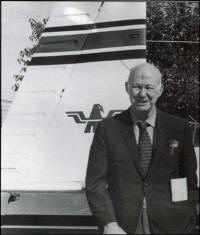Later, as chief engineer at Alexander
(1928-1929) he was responsible for the
Bullet, an advanced, high speed, low wing
monoplane. With Mooney's patented
retractable landing gear, it was a mild
sensation and ahead of its time.
Early in 1929, Mooney left Denver to form
the Mooney Aircraft Corporation with his
brother, Arthur B., in Wichita, KS. There he
designed and built a more advanced low-wing
monoplane, the Mooney A-1. Like the Bullet,
it was designed for efficiency. Then the
Depression hit the Mooney Corporation, and
it closed its doors in 1931.
By 1934, Mooney was with Bellanca, where he
spent a short time as chief engineer. During
this time, he greatly influenced the design
of the very successful Bellanca low-wing
wooden wonders, a version of which is still
being produced.
Then, becoming the vice president and chief
engineer at Monocoupe Aircraft, he developed
the Model G "Dart" and the Monocoach. The
Dart was unmistakably an Al Mooney airplane,
and when Culver Aircraft purchased the
design, prototype and tooling for the Dart
in 1938, Al followed right along with it.
During his days at Culver, Al designed the
famous and fully aerobatic Cadet. With its
elliptical wing and retractable landing
gear, the two-seat Culver Cadet was fast and
efficient. Over 350 of these
high-performance aircraft had been produced
by the time W.W. II erupted.
During the War, the Culver Company turned to
the production of radio controlled target
drones, and by the war's end had produced
over 3000 of the PQ-8 (a drone version of
the Cadet) and the PQ-14 (its successor)
target drones. The tricycle geared, bright
red PQ-14 was the direct ancestor of the
Mite.
In July 1946, in partnership with C.G.
Yankey and W.L. McMahon, the
Mooney brothers resurrected the Mooney
Aircraft Corp. Al was the general manager
and chief engineer, while Art Mooney
was the production manager. Bill Taylor
was the sales manager and chief pilot,
while Yankey financed the operation. Their
first offering was the Mooney Series18, an
all-wood single-seater with retractable
tricycle gear and a cantilevered, laminar
flow wing. Test flights continued through
1947 and certification was received in July,
1948. With its now-famous "backward" tail,
the Mooney "Mite" hit the sport aviation
world with a price tag of less than $2000,
and represented the cheapest, smallest
aircraft to be produced in quantity.
The first Mites produced were certified to
use the 25 h.p. liquid-cooled Crosley Cobra
automobile engine. These engines were
mounted back-to-front and drove the
propeller through a belt-driven reduction
gear. However, due to numerous technical
problems, they were soon recalled and
replaced, at no charge to the owners, with
65 h.p Lycomings.
The economy and efficiency of the Mite with
the 65 h.p. engine was remarkable:
Three-and-a-half to four gallons per hour at
cruise between 120 and 130 m.p.h. This
miniature "fighter plane" was cheap to buy
and fun to fly. It had a lot of appeal to
ex-military pilots recently returned from
the War. To celebrate his 25th anniversary
as an aircraft designer, Al Mooney
set an unofficial distance record of 1312
miles in a Mite.One drawback of the Mite was
its limited carrying capacity. The pilot
could easily equal 25% of the gross weight
of the airplane. In the model with the full
electrical system, the baggage compartment
was taken up by the battery, leaving a
baggage capacity of only 40 lb.
The Mite had a hand-operated, retractable
gear system which was difficult for some to
operate. Pilots who had trained on other
small aircraft with fixed landing gear
occasionally forgot to lower the gear for
landing in the Mite. This is said to have
happened to an embarrassed Al Mooney while
he was giving a demo flight. This incident
prompted him to invent the unique Wig-wag
warning device which waves from the
instrument panel when the pilot
throttles-back with the gear up. Mooney had
confidence in the rugged little Mite. Mooney
advertisements claimed that belly-landings
were a quicker, safer way to stop in
difficult landing situations, and would
cause little damage.
There were many ingenious features in
Mooney's airplane. A small Plexiglas window
in the floor permitted the pilot to easily
observe the nose wheel position. The
Safe-Trim mechanism, operated by a small
handle on the left side of the cockpit,
integrated the flaps and stabilizer. Rubber
disks used in the landing gear resulted in a
virtually problem-free shock absorber
system.

In May, 1951, during the Korean war, Mooney
conceived a militarized Mite. At their own
expense, they developed the M-19
"Cub-Killer", a "counter-liaison" aircraft,
featuring a 90 h.p. engine with a Flottorp
constant speed propeller and two .30 caliber
machine guns in the wings. The gross weight
was 1450 lbs. and it achieved a top speed of
150 m.p.h. Although successful strafing
demonstrations were given for the US
military, no purchase orders were received.
In 1953, for economic reasons Mooney moved
to Kerrville, Texas, where production
continued. The M-18C and M-18L, now named
the Wee Scotsman, featured the 65 h.p.
Continental A65-8 and the Lycoming O-145-B.
However, the M-18L was soon to be
discontinued because the Lycoming engines
were no longer available. A plaid-coloured
paint job on the vertical fin using
Scotchlite reflective material made it the
first plane to be reflectorized for safety.
It also had a greater fuel capacity,16
gallons instead of 12, extending the range
from 290 to 420 miles for Continental model,
and from 355 to 465 miles for the Lycoming
model. With an optional 6 gallon fuel tank
installed in the wing, the range extended to
610 miles. A Flottorp controllable-pitch
propeller was now available for $189. The
price of a new Mite was $2840, or you could
buy one for $2400 without the engine.

